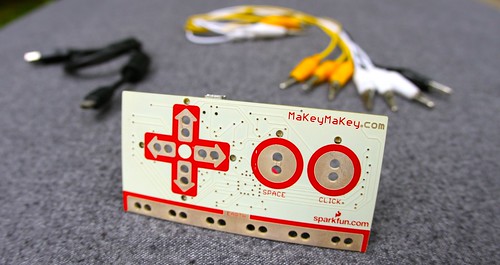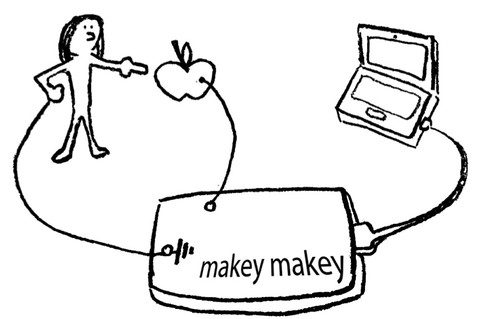What is Hi5! ?
'Hi5!' is an one of the interactive features within the MusicLab trailer that will be touring the south-west of England as of April 2014. For more about MusicLab itself follow the following link:
...or if you would like to know more about my own personal involvement you can read my previous post in which I provide an overview to MusicLab here.
In it's basic form, Hi5 is an exploration of the instruments of the orchestra through the medium of sound, but with the added twist that the participant must choose the instrument and how it should be played. There are 14 instruments accompanied by 4 methods of playing them - referred to as techniques, for the sake of simplicity - and they are all represented by two-dimensional stencil images.
…but why is it called Hi5! then?
As it is an interactive feature, there must be some way for the participant to engage with it…put simply, you literally trigger the sound. Each instrument and technique image has a corresponding metal 'node' that connects to an Arduino based human interface device (HID) that goes by the name of MaKey MaKey.
 |
| The MaKey MaKey HID - (c) makeymakey.com, 2014 |
This device is recognised by computers in the same way a keyboard would be and as a result can be used to input letters, numbers, or symbols that you might find on any standard computer keyboard. The MaKey MaKey device is designed to output values (via USB connection) as a result of closing a low-voltage circuit. The circuit can be completed using metal wires or any conductive material, but what makes it more fun to use is that you can be a part of this conductive chain. In fact, a chain of 10 people, probably more, will work and it is completely safe too.
As a result this, the name Hi5! was derived from the suggested means of closing the circuit when being used by two people:
As a result this, the name Hi5! was derived from the suggested means of closing the circuit when being used by two people:
"Choose an instrument, Decide how to play it…and high five!"
 |
| (c) makeymakey.com, 2014 |
Design
Hi5! is, in its most basic form, a wooden board with an acrylic surface that is embedded with conductive metal nodes. It is roughly 1.5 metres tall by 1 metre wide and can be mounted onto a wall with the use of brackets at the back.
Whilst I had a high involvement in this part of MusicLab, the design was ultimately decided upon by the production manager and finalised by a freelance designer. The board itself was constructed by 3FD and I found myself in an advisory role in which suggestions and critical features were put forward to ensure that the board would work as intended. The main risk involved with Hi5! was that is was mainly based on theory until we could get our hands on the board and get it prepared for MusicLab. I did a lot of extensive testing, which provided the basis of all suggestions that were put forward to the designers, but the success of the board was dependant on how it would turn out once constructed.
As mentioned above, the instruments and techniques are represented as two-dimensional stencils and each have a corresponding conductive metal node. They all look the same and that would be true except that the technique nodes have an extra inner-element that is critical to the operation of Hi5! I will explain the role this has in more detail during a future post as it is software related, although it should be noted that it is an independent connection that has to remain insulated from the surrounding node in order to operate correctly.
 |
| The Hi5! board |
The Instruments
The more observant readers might have realised that there are in fact more instruments in a typical orchestral setup than the fourteen featured on the Hi5! board. The amount of instruments were limited by a number of factors such as the technology - the MaKey MaKey only allows for 18 inputs - and physical dimensions - considerations had to made in order to make the board accessible to people of all ages and abilities - but crucially, not all instruments lend themselves well to the concept of Hi5!
For an instrument to be considered for the board, it must be playable/ possible to generate sound from the following methods or techniques:
- Hand
- Sticks/ Mallets/ Beaters
- Bow
- Wind
To give you a better idea of how this concept lends itself well to some instruments, but less so for others, consider this:
A member of the percussion section, such a mettalophone, can be played using mallets - the traditional method of playing - or, if like the Vibraphone it has a motor and resonating chambers, an effect similar to the vibrato of a wind instrument can be created - hence the link to the wind technique. There is a unique method of playing an instrument like the Vibraphone and that is by using a bow - a nice sound that is achieved by bowing one end of a tuned bar - and perhaps a slightly less conventional practice of using the hand - whether to flick the tuned bar or hit it.
However...
A woodwind instrument, such as the Clarinet, only works well with the 'wind' technique due to the simple fact that wind/air/breath is the core element driving behind the sound of the instrument. That means for the other three techniques - mallets, bow and hand - I had to be a little bit more creative or basic, in some cases. As a result the sounds produced by a clarinet when combined with the hand is the sound of keywork - something simple, but heard when sat in close proximity to a clarinetist - and a similar sound of the wood of a Clarinet being hit by a mallet and bow - something that isn't really a technique, but at the same time should tell the listener a small amount about the materials and density of the instrument.
The final choices of instruments also take into consideration the other features of MusicLab based on what else was on offer in terms of instrument exploration. 'The Instruments' feature being the prime focus in this case as it includes a French Horn, Cello, Clarinet and Timpani. Hi5! does not include any of these, with the exception of the Timpani, as 'The Instruments' offers a hands on experience of each instrument and as such I felt it would be best to leave as many of these out as it would result in some minor repetition between features.
The full list of instruments included on Hi5! is as follows:
- Tam-Tam
- Tuba
- Harp
- Flute
- Double Bass
- Cymbals
- Mettalophone
- Trumpet
- Snare Drum
- Bassoon
- Timpani
- Violin
- Crotales
- Oboe
Audio
Just a quick mention about the audio. The audio samples that are triggered as a result of an interaction were sourced or recorded by myself.
A list of the instruments that I recorded:
- Bassoon, Crotales, Cymbals, Double Bass, Harp, Vibraphone, Tam-Tam
The instruments that were sourced or sampled:
- Flute, Oboe, Snare, Timpani, Trumpet, Tuba, Violin,
- Minor sampling: Crotales, Cymbals, Tam-Tam
N.B. Special thanks to Havering Music School for allowing me access to record a selection of percussion instruments.
Easter Egg
Inspired by various forms of media that have chosen to include an 'easter egg' or hidden feature, I have added a simple 'extra' of my own. If you would like to find out more about it then feel free to read the next post in which I will be discussing the back-end design of Hi5! That said, I won't be disclosing the exact details of the easter egg...that would be making things too easy!
No comments:
Post a Comment